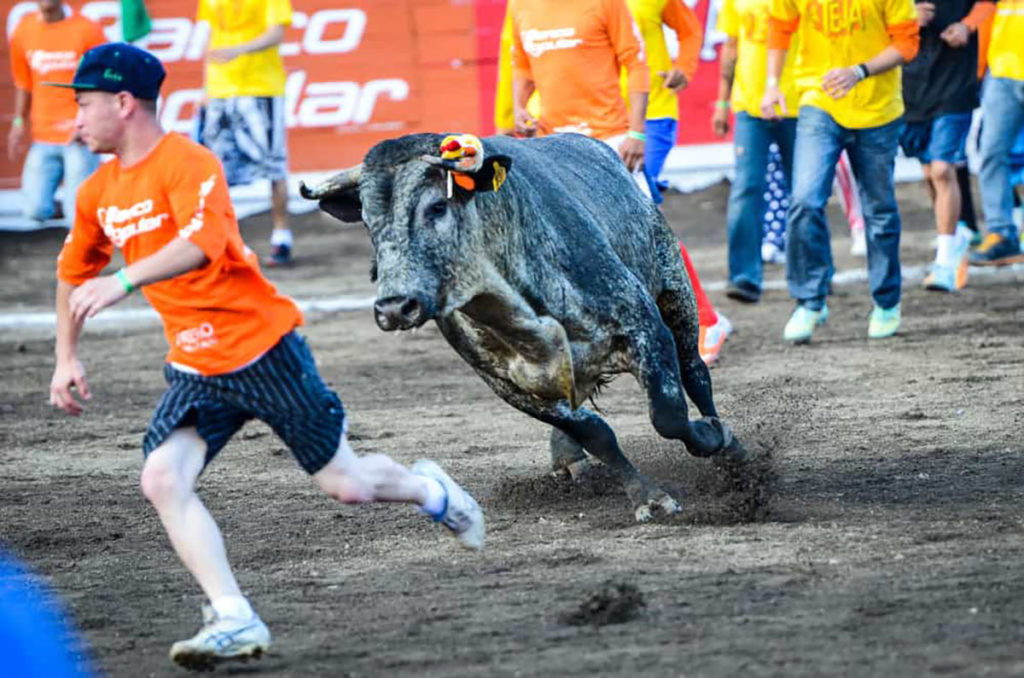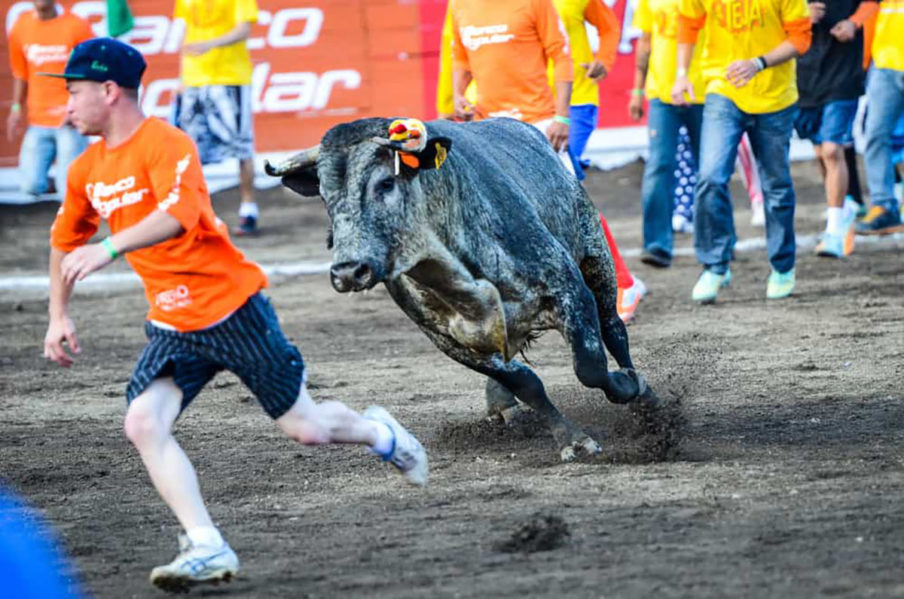
Costa Rica, a huge draw for wildlife and ecotourism, surprises visitors with a unique cultural tradition: Toros a la Tica, a distinctive form of bullfighting that draws crowds during the festive season from December to April. Unlike the ritualized combat of Spanish bullfighting, this Tico-style event prioritizes the bull’s strength and community spirit, with no harm to the animal.
For families exploring Costa Rica, especially during the Fiestas de Zapote, understanding this tradition offers a chance to engage with local culture. This guide covers what Toros a la Tica entails, its role in major festivals, safety considerations, and how parents can plan a family-friendly experience.
Understanding Toros a la Tica
Toros a la Tica redefines bullfighting. In Spain, a matador performs a choreographed duel, often ending in the bull’s death after being weakened. Costa Rica’s approach, shaped by strict animal welfare laws, forbids harming the bull, with penalties including fines up to ₡21 million ($37,600) or jail time. Instead, dozens of participants, called improvisados, enter a ring to dodge or taunt a single bull, creating a chaotic, adrenaline-fueled spectacle.
These aren’t trained bullfighters but everyday people—construction workers, security guards, or even tourists—dressed as superheroes, clowns, or wrestlers, adding a playful twist. The event resembles Pamplona’s Running of the Bulls, but confined to a 3,000-seat arena, like the one in Zapote.
The bulls steal the show, earning fame over the improvisados. Legends like Malacrianza, dubbed “El Toro Asesino” and El Raton became household names, with Malacrianza inspiring a beer and a statue after a decade-long career. Surviving an encounter with these bulls is a badge of honor, making the event a celebration of raw power and communal fun, distinct from the elite spectacle of Spanish corridas.
When and Where to Catch Bullfighting Events

Bullfighting events occur year-round, often tied to local festivals in regions like Guanacaste, Limón, or Puntarenas. The highlight is the Fiestas de Zapote, held in Zapote, a district east of San José, from December 25 to January 5. This week-long festival, marking its 56th year in 2024, features two daily bullfighting sessions—afternoon and evening—with 10 to 12 bulls and 20 to 30 improvisados per event.
Broadcast live on multiple channels, it’s a national phenomenon, with ticket prices ranging from $12 to $50 based on seat location and time. The latest season saw a triumphant return after COVID-19 cancellations, with 30% capacity limits in 2021 giving way to packed stands.
The Palmares Fair, a two-week event in mid-January near San José, offers another major bullfighting venue, alongside carnival rides and horse parades. Smaller festivals, like the Los Angeles de Nicoya in Guanacaste, provide a more intimate experience. Families find Zapote and Palmares most accessible, with ample activities to complement the bullring action.
Cultural Roots of Toros a la Tica
Tracing back to Costa Rica’s colonial era, Toros a la Tica emerged from livestock traditions and Spanish influences, evolving into a populist spectacle. A 2015 University of Costa Rica survey revealed 94.5% of Ticos have watched it on TV, 50.2% have attended, and 62.7% enjoy it, underscoring its cultural weight.
The Fiestas de Zapote, established in 1969, amplify this with the Tope Nacional, a parade of 5,000 riders showcasing ornate horses. Food stalls offer tamales and churros, while rides like Ferris wheels and bumper cars create a carnival atmosphere, drawing families and tourists alike.
Participants add flair, dressing as Batman, Superman, or luchadores, turning the ring into a theater of absurdity and courage. Spectators laugh and cheer as bulls chase improvisados, fostering a shared sense of thrill. This communal spirit distinguishes Toros a la Tica as a cornerstone of Tico identity, blending tradition with modern entertainment.
Animal Welfare and Ongoing Debates
Costa Rica’s animal welfare laws, enforced by the Ministry of Agriculture and Livestock, ensure bulls are treated as athletes, not victims. Executive Decree #19,183 mandates veterinary inspections before, during, and after events, with bulls resting 30 days between appearances. Ranchers like Luis Collado describe their bulls as “playing” monthly, cared for meticulously.
Yet, controversy persists. Animal rights groups, including the Coordinadora por la Liberación Animal, argue the events cause stress, citing hyperventilation and elevated stress hormones. The III Day for Animal Liberation in December 2024 saw protests pushing for a ban, with critics like Yayo Vicente calling it a violent, macho tradition harmful to both bulls and societal values.
A 2023 National University survey showed 46.4% of Ticos favor a ban, reflecting deep division. Despite this, the tradition’s popularity endures, supported by strict oversight and cultural pride.
Safety for Participants and Families

Improvisados face real risks, with over 150 injuries annually at Zapote, from bruises to gorings, and occasional deaths tied to bulls like Malacrianza, retired in 2014. Participants must be 18, sober, and insured, but the lack of training amplifies danger. Spectators, however, are safe in the stands, with barriers preventing bulls from reaching the crowd.
For parents, the event’s intensity raises questions about suitability for kids. The chaotic scenes can unsettle younger children, and critics argue it glorifies risk. Still, Tico families attend in droves, viewing it as cultural heritage. Daytime sessions, less rowdy, are better for kids, and parents should discuss the event’s context to balance enjoyment with awareness.
Planning a Visit
Attending the Fiestas de Zapote or Palmares Fair requires preparation. Secure tickets early through official websites or local vendors, as evening sessions sell out. Dress for outdoor conditions—sneakers, hats, sunscreen—and bring cash for food stalls serving empanadas or cotton candy. The festival grounds offer carnival games and rides, keeping kids entertained outside the bullring.
If bullfighting feels too intense, watch it on TV at a local restaurant or focus on family-oriented events like the Tope Nacional or Palmares horse parades. Discuss animal welfare with older kids to spark thoughtful conversations about culture and ethics. The festival’s fireworks and mariachi bands add a festive touch, ensuring a well-rounded experience.
Bull Riding: A Complementary Thrill
Between bullfighting sessions, some festivals feature bull riding, where cowboys or ranchers aim to stay atop a bucking bull. Resembling American rodeos, this event showcases skill and grit, offering a structured alternative to the improvisados’ chaos. It’s a hit with families seeking a less frenetic spectacle.
Recent Trends and Future Prospects
The COVID-19 pandemic halted the 2020 Zapote Fair, prioritizing hospital resources, but the tradition rebounded a few years ago. This season saw robust attendance, though animal rights protests and proposed legislation signal potential changes. Stricter regulations or a ban could reshape the tradition, but for now, Toros a la Tica remains a cultural juggernaut, balancing heritage with modern ethics.
Event Comparison Table
| Event | Location | Timing | Highlights | Family-Friendly Features |
|---|---|---|---|---|
| Fiestas de Zapote | Zapote, San José | Dec 25–Jan 5 | Bullfighting, Tope Nacional, carnival rides | Food stalls, rides, daytime sessions |
| Palmares Fair | Palmares, Alajuela | Mid-January (2 weeks) | Bullfighting, horse parades, live music | Carnival games, relaxed atmosphere |
| Regional Festivals | Guanacaste, Limón | Year-round (varies) | Smaller-scale bullfighting | Authentic, less crowded |
Wrapping Up Your Visit
Toros a la Tica captures Costa Rica’s spirit—bold, communal, and rooted in tradition. For families, it’s a chance to immerse in local culture, from the bullring’s adrenaline to the festival’s tamales and fireworks. Plan thoughtfully, balancing the event’s intensity with kid-friendly activities, and use it to explore Costa Rica’s values of heritage and animal care. Whether in the stands or at a food stall, the Fiestas de Zapote delivers memories that resonate long after the bulls return to the ranch.

